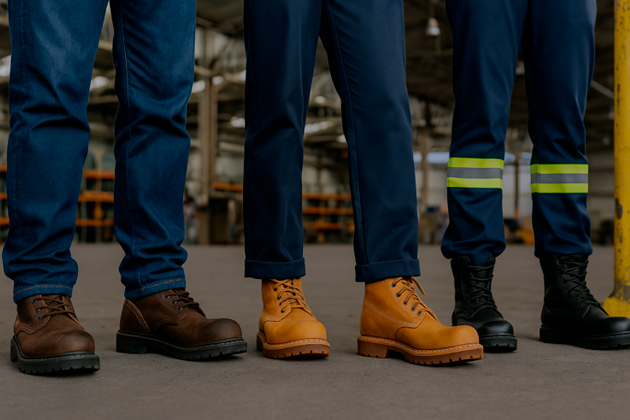Corporate wellness is no longer a trendy HR buzzword, it’s a bottom-line strategy. In today’s labor landscape, where burnout is rampant and skilled workers are hard to retain, a wellness & safety footwear program can mean the difference between thriving teams and high turnover.
But here’s the catch: most corporate wellness efforts still focus on surface-level perks, snack bars, meditation apps, and step challenges. Meanwhile, the very basics of on-the-job well-being are often overlooked. Take something as foundational as protective gear. The right footwear, for instance, doesn’t just reduce fatigue or prevent injury, it signals that a company actually values its workforce.
That’s why more companies are adopting a dedicated safety footwear program as part of their overall wellness strategy. These programs support not just compliance, but culture. When done right, they reduce injury costs, improve morale, and become a visible emblem of care. So what separates the flashy wellness plans from the ones that actually work? Let’s dig into five core secrets behind truly successful corporate wellness programs.
Secret 1: Design for Real Work, Not Just Optics
The most effective wellness programs do not chase trends. They solve problems. While kombucha bars and nap pods look good in a brochure, they rarely affect the average worker’s day. A real wellness strategy begins by identifying what impacts a shift: physical strain, comfort, and safety.
For example, a 2020 study in the Journal of Occupational and Environmental Medicine found that musculoskeletal disorders are among the leading causes of lost workdays, particularly in labor-intensive industries. Addressing these issues starts with fundamentals. Footwear that reduces fatigue, supports posture, and prevents long-term injuries is not a luxury. It is a strategy.
Companies in construction, manufacturing, and logistics increasingly recognize that safety gear is wellness gear. Investing in supportive boots that absorb shock and meet safety standards directly improves daily life on the job. Over time, these decisions lower healthcare costs and boost productivity. Perks that feel good for a moment will never outperform essentials that protect people every day.
Secret 2: Make It Hyper-Relevant to Job Roles
A wellness program that treats every employee the same is guaranteed to underperform. The health risks faced by an office-based marketing team are nothing like those of a warehouse crew, a lineman, or a construction foreperson. One-size-fits-all initiatives often feel irrelevant, and when employees cannot see how a program fits their world, they ignore it.
The Centers for Disease Control and Prevention (CDC) recommends tailoring wellness strategies based on job hazards, stress exposure, and physical demands. Personalized wellness planning, the agency notes, improves participation and outcomes. For example, a driver who spends ten hours a day on their feet or in motion may benefit from compression gear, anti-fatigue mats, and high-traction footwear. A desk-based worker might need posture-correction training, mental health support, and break strategies to reduce eye strain.
When wellness is customized, adoption increases. Programs feel like investments, not impositions. Employees respond when they see that leadership understands what their day is actually like.
Secret 3: Integrate With Safety and Risk Mitigation
Wellness and safety are often managed in separate silos, but they belong on the same page. Companies that combine these priorities gain a measurable edge. Wellness programs that include safety equipment reduce both physical harm and financial risk. According to the National Safety Council (NSC), the average cost of a workplace injury in the United States is over $42,000 per incident. That figure includes lost productivity, medical expenses, administrative costs, and legal fees. Many of these costs are preventable.
Take footwear, for example. Slips, trips, and falls account for a significant percentage of occupational injuries, particularly in warehousing, construction, and manufacturing. High-quality boots with proper tread, ankle support, and impact resistance drastically reduce these incidents. Integrating these essentials into a wellness program shows employees that care is not just theoretical. It is practical and visible.
The companies that invest in proactive risk mitigation, including proper footwear, often see fewer workers’ compensation claims and stronger insurance positions. These are not side effects of wellness. They are direct outcomes. When safety gear is framed as a core wellness asset, employees wear it with pride. Culture shifts when protection becomes part of well-being, not just policy.
Secret 4: Give Managers Skin in the Game
Even the best-designed wellness program will fizzle without leadership buy-in. When managers treat wellness as an optional perk rather than a core responsibility, participation remains low. But when team leads model healthy behavior, recognize effort, and link wellness to performance, something powerful happens: the culture shifts. According to a Gallup study, employees who feel their manager genuinely cares about their well-being are more than twice as likely to be engaged at work. Engagement, in turn, correlates with higher productivity, lower absenteeism, and reduced turnover.
Managers do not need to become fitness coaches or mindfulness gurus. They simply need to show up. A foreman who ensures crew members get quality protective gear, checks on fatigue levels, and advocates for break time becomes a wellness leader without ever using the word “wellness.” Some companies build this accountability into KPIs. Others use team-based incentives, in which safety metrics, participation rates, or injury-free days lead to shared rewards. Whatever the format, the point is clear. When managers participate, others follow. When they ignore wellness efforts, others will too.
Secret 5: Measure What Matters (Then Iterate)
A wellness program without measurement is just guesswork. Too many companies launch initiatives, collect feel-good feedback, and declare success without checking whether anything actually improved. Real success demands data, not only tracking, but honest assessment and a willingness to adjust.
The Harvard Business Review reports that while over 80 percent of large employers in the U.S. offer wellness programs, only a small fraction rigorously measure outcomes beyond participation. The right metrics depend on the goals. Are you trying to reduce injuries? Track incident reports and workers’ compensation claims. Is fatigue the issue? Monitor absenteeism, overtime hours, and productivity benchmarks. If mental health is on the table, anonymous surveys and utilization of support services matter.
And if the program includes physical gear, like a new safety footwear initiative, look at before-and-after data on slips, falls, and back strain. Talk to employees. Watch behavior change. Then refine. No program launches perfectly. The best ones evolve. Measure, listen, adapt, and keep going.
From Compliance to Culture
The most effective corporate wellness programs do not rely on surface-level perks or buzzwords. They recognize that well-being starts where the work happens, on the floor, on the line, in the field. Real wellness is woven into operations, not tacked on. By focusing on relevance, safety, leadership, and measurable outcomes, companies can build programs that go beyond checking boxes. They create environments where employees feel supported, protected, and empowered to do their best work.
Starting with something as practical as a safety footwear program by Overlook Boots sends a clear message. It shows that wellness is not just a corporate initiative. It is part of the company’s identity. Wellness should not live in a handbook. It should live in the boots, tools, and culture that keep people going, day after day, job after job.










